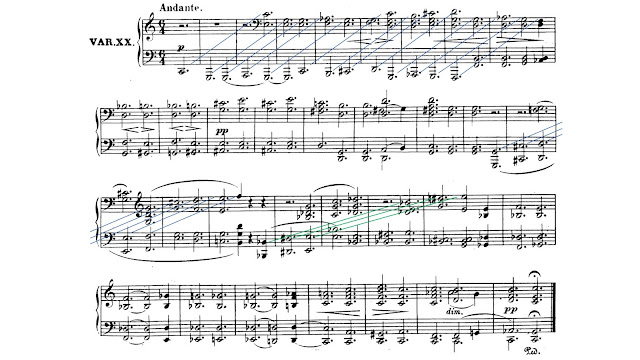Beethoven -- or whom I occasionally like to call "the male Emilie Mayer" -- was born 250 years ago this month. His music, and discussions about his music, have been recently getting even more airtime than usual as a consequence of this sestercentennial, like this piece in the New York Times, where various luminaries find passages in the composer's music that are "resigned," "wondrous," "euphoric," 'furious," "eruptive," "rampant," "spiritual," "life-affirming," "passionate," "disruptive," "experimental," "daring," "heroic," "incredible," "extraordinary," "ferocious," "heart-stopping," "playful," "combative," "maniacal," "lyrical," "modest," "heartfelt," "reflective," "unpredictable," "transcending," "gloomy," "thrilling," "sophisticated," and "sublime."
I have another passage and another adjective to add to the list. The passage is from his Diabelli Variations, one of the works cited in the New York Times article. Below is the score for the twentieth variation.
This is strange music. For one nit-picky example of this strangeness, as enclosed in red below, this music as notated contains ascending thirds of both diminished and augmented varieties, each starting on the note two semitones below C (notated as A sharp in the diminished third and B flat in the augmented third).
As shown with diagonal lines below, a fairly strict but intermittent outer-voice canon with a delay of two measures -- stretching to three measures in its last appearance, indicated in green -- does offer some organization to this music's structure, but not all of it.
The one moment I find most bizarre in this already strange music, a moment that lies outside of the canon shown above but insinuated with the diminished third shown above that, is in m. 11. The stack of notes in the second half of this measure, enclosed below, is deliciously flabbergasting, for multiple reasons.
First, this is a root-position tonic triad in the key of the theme and the entire variation set: C major. Outside of its local context and ignoring its top note for now, this kind of chord should be the most stable sonority in the entire work's tonal fabric. And yet not the theme, nor any variation before or after this one, places a root-position C-major triad at this point in the two-reprise form: if anything, at this point in the form, the music is pulling away from the orbit of C major as a key, and certainly not landing on it as a stable chord.
Second, a fully-diminished chord occurs immediately before this C-major chord. Such chords, outside of other contextual patterns, are most likely to resolve to a consonant triad whose root is one semitone above some pitch -- octave aside -- in the fully-diminished seventh (as a vii°7) or to a consonant triad whose root is the same as some pitch in the fully-diminished seventh (as a "common-tone chord"). The two recompositions of the eleventh measure below show one example of each -- note how soprano and bass lines maintain the same contour of those in Beethoven's original, which matches the same of the prior two measures, which -- at least in the soprano -- matches the theme's sequential continuation in mm. 9-12.
Beethoven's resolution does neither of these. Rather, it resolves in a third, and the only remaining, way: to a consonant triad whose root is one semitone below some pitch -- octave aside -- in the fully-diminished seventh. This third way is not unheard of in classical tonal practice. However, in this third way, two voices typically remain as common tones (which Beethoven does), and each of the two moving voices typically uses a melodic interval that is typically no larger than two semitones (as heard) and a step (as seen) (which Beethoven does not do, on both the hearing and seeing fronts). Furthermore, in this third way, the music is typically preparing a subsequent tonic that -- or at least a subsequent chord whose root -- is a perfect fifth below the root of the consonant triad to which the fully-diminished seventh resolves. In other, odder words, the consonant triad is "dominantized." In this case, with C as the "dominantized" chord's root, that would mean that the eleventh measure's strangeness might be mitigated with an F root or tonic soon thereafter, but no such emphasis on F materializes; rather, as in the theme, the music modulates to G. (If C's function is to be "-ized" for this purpose, it should be "subdominantized," not "dominantized."). The recomposition below shows a typical third-way continuation, reversing the motivic soprano ascent to achieve even higher atypicality.
The C-major chord does make some sense when m. 12 repeats m. 11 verbatim (capitalizing on the clichéd maxim better known in jazz that it's not a wrong note if you repeat it), and, in retrospect, the C-major chord is "subdominantized" or "predominantized" as the music moves to a D7, the dominant in G. But, for me, the bizarreness remains. Perhaps Beethoven wanted the performer to prepare the listener for this bizarreness when he prescribed a terraced dynamic change (the pianissimo, from piano) in m. 11, in the middle of the four-measure sequential continuation -- something he does neither in the theme nor in any other variation.












































